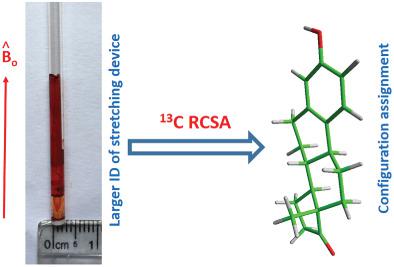当前位置:
X-MOL 学术
›
Magn. Reson. Chem.
›
论文详情
Our official English website, www.x-mol.net, welcomes your
feedback! (Note: you will need to create a separate account there.)
Elucidating natural product structures using a robust measurement of carbon residual chemical shift anisotropy combined with DFT
Magnetic Resonance in Chemistry ( IF 1.9 ) Pub Date : 2020-03-25 , DOI: 10.1002/mrc.4975 Akhi Das 1 , Nilamoni Nath 1
Magnetic Resonance in Chemistry ( IF 1.9 ) Pub Date : 2020-03-25 , DOI: 10.1002/mrc.4975 Akhi Das 1 , Nilamoni Nath 1
Affiliation

|
Determination of configurations and conformations is a very crucial step in the structural characterization of small molecules. Apart from utilizing isotropic J-couplings and NOEs measured in isotropic solution, anisotropic NMR data such as residual dipolar couplings (RDCs) and residual chemical shift anisotropies (RCSAs) were also used to elucidate complex small molecule structures. Measuring RCSA has always been historically difficult due to isotropic shift effect accompanied by molecular alignment and therefore, only occasionally applied in a few examples. Here, we are presenting a robust measurement of carbon RCSAs using a micro gel-stretching device to determine the structures of a few small molecules.A systematic study on how different DFT computed anisotropies of chemical shift anisotropy tensors impact RCSA data interpretation has also been discussed. We also discuss the effect of utilizing various carbons as reference nuclei for RCSA data extraction as well as the orientation behavior of estrone in orthogonal alignment media.
中文翻译:

结合 DFT 结合碳残留化学位移各向异性的稳健测量来阐明天然产物结构
构型和构象的测定是小分子结构表征中非常关键的一步。除了利用各向同性 J 耦合和在各向同性溶液中测量的 NOE 外,各向异性 NMR 数据如残余偶极耦合 (RDC) 和残余化学位移各向异性 (RCSA) 也用于阐明复杂的小分子结构。由于伴随分子排列的各向同性位移效应,测量 RCSA 在历史上一直很困难,因此,仅偶尔应用于少数几个例子。在这里,我们使用微凝胶拉伸装置对碳 RCSA 进行了稳健的测量,以确定一些小分子的结构。还讨论了关于不同 DFT 计算的化学位移各向异性张量的各向异性如何影响 RCSA 数据解释的系统研究。我们还讨论了利用各种碳作为参考核对 RCSA 数据提取的影响以及雌酮在正交排列介质中的取向行为。
更新日期:2020-03-25
中文翻译:

结合 DFT 结合碳残留化学位移各向异性的稳健测量来阐明天然产物结构
构型和构象的测定是小分子结构表征中非常关键的一步。除了利用各向同性 J 耦合和在各向同性溶液中测量的 NOE 外,各向异性 NMR 数据如残余偶极耦合 (RDC) 和残余化学位移各向异性 (RCSA) 也用于阐明复杂的小分子结构。由于伴随分子排列的各向同性位移效应,测量 RCSA 在历史上一直很困难,因此,仅偶尔应用于少数几个例子。在这里,我们使用微凝胶拉伸装置对碳 RCSA 进行了稳健的测量,以确定一些小分子的结构。还讨论了关于不同 DFT 计算的化学位移各向异性张量的各向异性如何影响 RCSA 数据解释的系统研究。我们还讨论了利用各种碳作为参考核对 RCSA 数据提取的影响以及雌酮在正交排列介质中的取向行为。











































 京公网安备 11010802027423号
京公网安备 11010802027423号